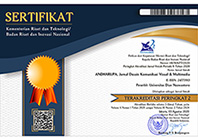IDEOLOGI PATRIARKI DALAM FILM (SEMIOTIKA JOHN FISKE PADA INTERAKSI AYAH DAN ANAK DALAM FILM CHEF)
Abstract
Abstrak
Film Chef yang beraliran drama – komedi ini dirilis pada tahun 2014 dengan menghasilkan US$45 Juta pada dua minggu penayangannya di bioskop seluruh Amerika dan masuk jajaran film box office dengan rating 7,3/10 versi IMDb. Film ini menghadirkan banyak interaksi antara ayah dan anak yang bisa menjadi acuan bagi orang tua dalam membangun interaksi terhadap anak. Interaksi karakter Carl (Ayah) dan Percy (Anak) yang menjadi subjek penelitian ini diulas dengan pendekatan semiotika John Fiske. Hasil penelitian ini tersaji pada tiga level analisis semiotika John Fiske yaitu level realitas yang digambarkan dengan interaksi karakter Carl dan Percy di ruang-ruang sempit dan padat pada area food truck “El Jefe” maupun area lain baik interior (dalam ruang) maupun exterior (luar ruang). Level representasi yang digambarkan dengan sudut pengambilan gambar (angle) dan komposisi yang membawa penonton untuk tetap terlibat dalam setiap interaksi antar karakter. Terakhir level ideologi patriarki yang menjadi temuan dalam penelitian ini bahwa ideologi patriarki yang dihadirkan dalam film ini bisa dijadikan acuan dalam membangun interaksi ayah dan anak sehingga anak tersebut tidak kehilangan sosok orang tuanya.
Kata Kunci : interkasi sosial, patriarki, realitas, semiotika
Abstract
This drama-comedy film, Chef, was released in 2014 with the US $ 45 million in two weeks of screenings in theaters across America and entered the ranks of box office films with a rating of 7.3/10 of the IMDb version. This film presents many interactions between father and son that can be a reference for parents in building interactions with their children. The interaction of Carl (Father) and Percy (Son) characters are the subjects of this study are reviewed by John Fiske's semiotic approach. The results of this study presented at three levels of John Fiske's semiotic analysis; the level of reality depicted by Carl and Percy's character interaction in narrow and dense spaces in the "El Jefe" food truck area and other areas both interior (inside) and exterior (outside room). The level of representation depicted by the camera angle and the composition that brings the audience to remain involved in every interaction between characters. Finally, the level of patriarchal ideology found in this study that the patriarchal ideology presented in this film can use as a reference in building the interaction of fathers and children so that the child does not lose the figure of his parents.
Keywords: patriarchy, reality, semiotics, social interaction
Full Text:
PDFReferences
Creswell, J. W. (2007). Qualitative Inquiry And Research Design: Choosing Among Five Traditions. Sage Publications.
Denzin, N. K., & Lincoln, Y. S. (2009). Handbook Of Qualitative Research. Sage Publication, Inc.
Dezheng, F. (2012). Modeling Appraisal In Film: A Social Semiotic Approach Feng Dezheng. Shandong University.
Erica, R. H. (2010). Film As Identity Exploration: A Multimodal Analysis Of Youth-Produced Films. Teachers College Record, 112(9), 2352–2378.
Fahrian. (2017). Representasi Komunikasi Interaktif Budaya Barat Pada Film “ Chef ” Karya John. Ejurnal Ilmu Komunikasi, 5961(3), 248–262.
Fiske, J. (1985). The Semiotics Of Television. Critical Studies In Mass Communication, 2(2), 176–183.
Hasanah, R., & Taefur, I. (2016). The Shift Meaning Of Masculinity In Nivea Deodorant Men Invisible Black And White Advertising (Television Code By John Fiske). In International Conference On Transformation In Communication (ICOTIC).
Heller, M. A. (1982). Semiology: A Context For Television Criticism. Journal Of Broadcasting, 26(4), 847–854.
Holmes, D. (2005). Communication Theory Media, Technology And Society. Sage Publication, Inc.
Indiwan Seto Wahyu Wibowo. (2006). Semiotika Aplikasi Praktis Bagi Penelitian Dan Penulisan Skripsi Ilmu Komunikasi. Jakarta: Fakultas Ilmu Komunikasi Universitas Prof. Dr. Moestopo (Beragama).
Littlejhon, S. W., & Foss, K. A. (2009). Teori Komunikasi Edisi 9 (Terjemahan). Jakarta: Salemba Humanika.
Littlejhon, S. W., & Foss, K. A. (2016). Ensiklopedia Teori Komunikasi (Terjemahan). Jakarta: Kencana.
Mulyana, D. (2017). Ilmu Komunikasi Suatu Pengantar (Edisi Revisi) (Revisi). Bandung: Remaja Rosdakarya.
Mulyana, D. (2018). Metodologi Penelitian Kualitatif (Edisi Revisi). Bandung: Remaja Rosdakarya.
Nico, R. (2016). Analisa Semiotika Penggunaan Twitter Pada Film Chef (Studi Semiotika Charles Sanders Peirce Tentang Metode Buzz Marketing Dengan Menggunakan Twitter Dalam Film Chef). Universitas Telkom.
Nurul, A., & Nugroho, C. (2017). Representasi Pemikiran Marxisme Dalam Film Biografistudi Semiotika John Fiske Mengenai Pertentangan Kelas Sosial Karl Marx Pada Film Guru Bangsa Tjokroaminoto. Semiotika: Jurnal Komunikasi, 11(1), 1–33.
Setiawan, H. (2016). Aplikasi Semiotik Dalam Iklan Di “ Dunia Nyata ” ( Peningkatan Brand Awareness Dibalik Iklan Yang Membingungkan ) (Pp. 1–16). Retrieved From Https://Www.Researchgate.Net/Profile/Harry_Setiawan/Publication/
_Aplikasi_Semiotikdalam_Iklan_Di_Dunia_Nyata_Peningkatan_Brand_Awareness_Dibalik_Iklan_Yang_Membingungkan/Links/5ba5d0e5299bf13e60436a1c/Aplikasi-Semiotikdalam-Iklan-Di-Dunia-Nyata-P
Setiawan, H. (2019). Memiilih Diantara 7 Tradisi Ilmu Komunikasi Dalam Kerangka Filosofis. Jurnal Darussalam: Jurnal Pendidikan, Komunikasi Dan Pemikiran Hukum Islam, 11(1), 18.
Sobur, A. (2003). Semiotika Komunikasi. Bandung: Remaja Rosdakarya.
Spradley, J. P. (2007). Metode Etnografi. Yogyakarta: Tiara Wacana.
Suriasumantri, J. S. (2017). Filsafat Ilmu Sebuah Pengantar Populer. Jakarta: Pustaka Sinar Harapan.
Tseng, C. I. (2013). Analysing Characters’ Interactions In Filmic Text: A Functional Semiotic Approach. Social Semiotics, 23(5), 587–605.
Vera, N. (2014). Semiotika Dalam Riset Komunikasi. Bogor: Ghalia Indonesia.
Wulandari P.W, M. (2016). Representasi Peran New Media Dalam Membangun Reputasi Pada Film Chef (Analisis Semiotika John Fiske). Universitas Islam Sultan Agung.
DOI: https://doi.org/10.33633/andharupa.v6i02.3502
Article Metrics
Abstract view : 4284 timesPDF - 2470 times
Refbacks
- There are currently no refbacks.
indexed by:
Andharupa Journal (p-ISSN: 2477 - 2852 | e-ISSN: 2477 - 3913) is published by Dian Nuswantoro University, Semarang. This Journal is licensed under Creative Commons Attribution 4.0 International License.
























